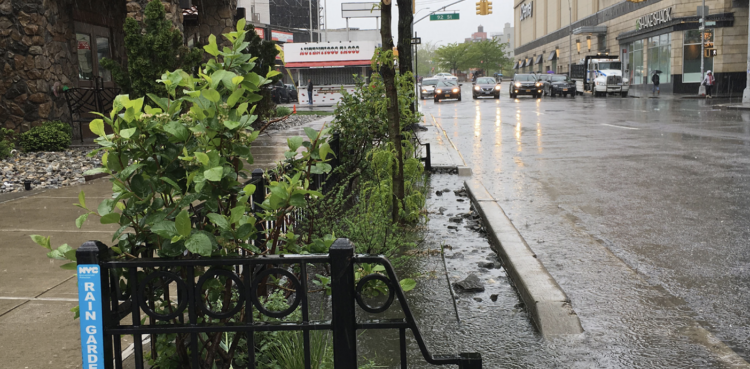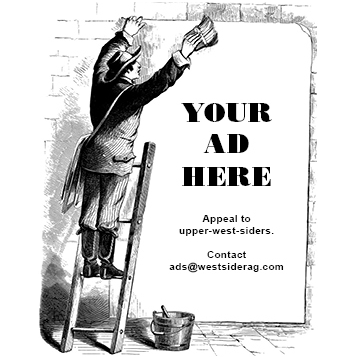
By Scott Etkin
Last week, the city’s Landmarks Preservation Commission (LPC) announced the approval of new rules aimed at streamlining the application process for making sustainability and resiliency improvements to historic buildings. The amendments also cut red tape for some cosmetic changes. The rules expand the range of permits that commission staff can approve without the need for public hearing and review by the full commission.
The new rules are a direct response to accelerating climate change and the increasingly urgent need to adapt buildings to extreme weather conditions. New York City’s buildings account for 70% of the city’s carbon emissions, and the commission’s changes are designed to expedite applications for such sustainability changes as installing solar panels and more efficient HVAC equipment. Other proposed changes to be fast-tracked, according to a commission news release, include new and expanded tree pits and adding planting beds and rain gardens to sidewalk areas in historic districts.

Landmark West, a preservation nonprofit group based on the Upper West Side, supported the environmentally-conscious focus of the rule changes when it presented testimony to the commission in May. But the group cautioned that the changes could put some commission decision-making out of public view.
“Landmarks are for the community and thus the community’s voice should be considered,” Landmark West wrote in its testimony. The rule changes also “will shift responsibility to the dedicated but overburdened preservation staff, who often cannot afford the time to visit each site or fully appreciate the significant elements of each landmark.”
Megan Fitzpatrick, director of preservation at Landmark West, said in a call with West Side Rag that, while these rule changes largely codify existing practices, the organization remains concerned that more permits can be issued without public hearings. The changes do not replace public hearings entirely but could speed up more straightforward permit requests, such as those involving signage and painting.
Community Board 7’s preservation committee meetings and the LPC’s public hearings are two of the main ways for people in the community to share their views on historic landmarks that are under consideration for changes. The calendar for the LPC’s hearings, which take place on Tuesdays twice or three times per month, can be accessed at the link.










Shuffling deck chairs. Over 70% of the UWS is covered by historic preservation laws. The greenest thing we can do as a community is allow more homes in our neighborhood, where people can move around without using a car. The average NYC resident generates 6 tons of carbon per year vs 16 for the average American. Every new home we allow here saves massive amounts of carbon, and overly broad historical landmarking (along with restrictive zoning) is a huge impediment to our ability to fight climate change. Historic preservation is important but you need to acknowledge that these laws come with a cost for the environment.
Josh P:
Pe other comments, high-rise buildings are bad for the environment.
Moreover NYC continues to grow luxury high-rise buildings filled with wasteful luxury amenities.
And people who order ecommerce 24/7 and food delivery rather than walking a few blocks to shop.
The blame is always about vehicles but as REBNY runs NYC, never mention about high buildings and climate change.
You can’t make it harder to drive, make transit worse for area workers who live outside Manhattan and not have a serious look at ending historic district landmarking on the UWS.
i don’t understand how one follows the other. can you elaborate?
It’s simple, many area workers as well as others who access the UWS cannot afford to live on the UWS. Many of these area workers drive or use transit, you’re making it harder to drive in NYC while at the same time trying to make transit service worse between the outer boros and Manhattan. You can’t make it harder to commute to work on the UWS while not giving people who can’t afford the UWS but work here the option of living here.
What is the carbon impact of the huge high rises it seems you are proposing to build and how many of them built on the upper west side are actually affordable and not empty second homes?
The tall new buildings are less affordable then the current 1 million dollar one bedrooms. I have been living here for 30 years and it continues to be more expensive. The city would have to build 80 story public housing buildings to gain affordable units
@Burton
Do you have any data to support either of your assertions?
1) Population density is strongly correlated with decreased per capita greenhouse gas emissions, for the obvious reasons that dense urban environments feature smaller average dwelling sizes and significantly less automobile travel (e.g. https://coolclimate.org/maps)
2) According to the Department of City Planning, the number of housing units on the Upper West Side decreased between 2010 and 2020.
High rises are generally more efficient per square foot because the shared floors/ceiling and walls cut down on heating and cooling costs. Think of the way a pack of dogs huddles together in the winter to conserve heat. New construction is also much more efficient than older buildings because of new regulations, building materials and techniques.
Our 450 unit building is inefficient and has a D rating, It would have to be knocked down to become more efficient
But glass towers lead to a higher greenhouse effect. The cost of building a taller building is more expensive because of the different types of steel provided, the more complex infrastructure required to supply water, gas, electric etc.
https://americanmind.org/salvo/solving-the-global-housing-crisis/
Yes, a 10-unit building requires more resources than a 5-unit building. But that’s the wrong comparison. A 10-unit apartment building is much more environmentally friendly than 10 single family homes. And people want to live in big buildings if we let them – no developer is going broke selling Manhattan apartments!
Josh –
High rise buildings – which keep going up in NYC – are bad for the environment.
A 10 story building is not the problem
Oh, and maybe linking to an article from a group that claims that it is “dedicated to restoring the principles of the American Founding to their rightful, preeminent authority in our national life” isn’t such a great move.
So don’t build glass towers. Plenty of places use prefabrication for high-rise construction, which cuts down on both waste and complexity. Infrastructure costs can be slashed by putting it on the outside of the unit in dedicated conduit which hooks in to pre-existing ports in the pre-fabrication, rather than trying to route it through living spaces during construction.
True, the construction unions won’t like it, but while I am a strong supporter of organised labour I’d say in this instance they’ll just have to lump it.
Instead of disputing a reputable professor, Joel Kotkin, who has written columns even in more left leaning publications, you call out the website that publishes his piece. Shows clearly that Kotkin is on to something.
This is helpful, especially around things like split ac systems that are finally becoming normalized here.
But it is a huge shame that they did not take this chance to streamline window permits. Replacing aging windows with modern insulated windows offers huge energy savings, and yet its still requires a public hearing and wild machinations to replace windows in this neighborhood.
Landmark Commission is probably responsible for keeping the awful windows my 1947 building has. And the 3 steps down into t he lobby. No common sense.
“ Accelerating climate change”… says who? Making unsupported statements is alarmist and dangerous.
It would be helpful to have a map of “Landmarked Buildings on the Upper West Side” that is possible to read. There is a lot of color coding that I am unable to understand even when enlarging it. Our building is “Landmarked” but on the map doesn’t appear to be identified as such. Is there a better map?
I use this website, which shows what is landmarked, as well as the LPC permits provided, by address. https://nyclpc.maps.arcgis.com/apps/webappviewer/index.html?id=0fe68c3ab3dc4bcabf45ef9276956dac
Great first step.
I hope Landmarks now streamlines the requirements and approvals for Local Law 11 work, which cause delays and dramatically increase costs.
My building has decorative keystones over windows, floors 4-10. All these keystones are identical.
For our current Local Law 11 work, the terra cotta keystones needing replacement on floors 4,5 and 6 need to be sourced from California, as that vendor has “only” a 10 month lead time. The only alternative vendor, in upstate NY, has even longer lead-times.
The identical keystones on higher floors can be replaced with cast stone made in NYC, and far less cost and delay.
We specifically asked Landmarks for a waiver to allow us to release all the keystones with cast stone. Landmarks turned us down, saying that if they approved our request, all buildings would want the same.
I realize this sounds improbable – it’s too dysfunctional. It is true. Besides increasing costs, this decision by Landmarks will force us to keep scaffolding up longer.
Don’t even get me started on the delays Landmarks causes replacing limestone…..
Buildings need to be updated and renovated. The Landmark Committee delay all of this. These buildings are old, inefficient, and cause most f the pollution.
Landmarks caused our building an extra $1,000,000 in Local Law work almost bankrupting the building. Lighter less costly materials could have saved a lot of money. Stylistically the repairs would have been the same just not the original 1900s stone etc.
I wonder if under the new rules Landmarks would still forbid my building from using insulated class in its front door.
So, do these new rules mean that scaffolding and sidewalk sheds will come down quicker?
Reducing transparency is never, ever a sound idea. For any organization. We must ask why? If they need another staff member they must find the $ for that.
High rise buildings are a significant source of emissions, make cities hotter, utilize materials that contribute to pollution, and contribute to climate change .
https://www.fastcompany.com/90666746/is-building-tall-really-best-researchers-dispel-the-myth-of-climate-friendly-skyscrapers